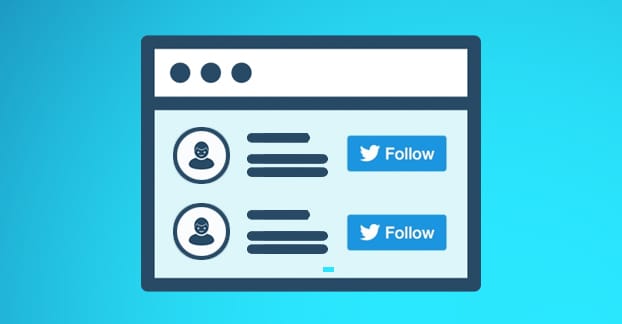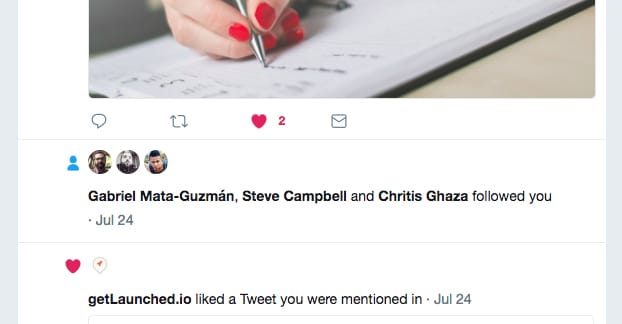As you use Twitter, people will follow you. The more consistently you use Twitter, the greater the rate of growth will be. The more appropriately you use it, the better it will be. There are a million articles written about how to grow Twitter quickly, including ours, so you have no lack of information for spurring on this growth.
When a new user follows you, should you follow them back? In my opinion, no. However, you’re free to do as you see fit.
Reasons to Follow Back
The first major perspective on Twitter use is the follow-back culture. These are the people who believe that relationships on Twitter should work a lot more like relationships on Facebook. See, on Facebook, when you friend someone, it’s a reciprocal relationship. You friend them and they friend you, in one action, approved by both sides. From there on, you each see posts from the other and can interact with each other and each others’ friends.
Twitter works more like the person-page relationship on Facebook. Someone follows you and they can see your content, but you don’t have to see theirs unless you follow them back. There’s no actual obligation to follow them back, and you don’t have to see a single bit of their content – other than their replies on your content – if you don’t want to.
The people who believe Twitter should have a more reciprocal relationship tend to follow everyone who follows them, and expect others to do the same. They want to build large social hubs with interaction back and forth. Admittedly, as a personal user, it can be a little sad to follow a bunch of people you like and respect, and never see return interaction from them, be it responses to replies or just a follow in return.
There are generally three positive arguments as to why you should follow everyone back, as well as some refutations to the arguments against the idea, though I’ll cover those in the next section.
Argument 1: It’s just good etiquette. Early on in the days of Twitter, it was good manners to follow anyone who followed you back. It made the whole platform feel much more social, and it equalized the playing field. Anyone, be they brand or personal user, could rack up a sizable following and be an “influencer” on Twitter. Except the concept of influencers didn’t really exist; no one person was more important than any other.
This etiquette concept has since largely fallen by the wayside, and you have unscrupulous brands to thank for that. Brands would swoop in and follow as many people as they could, and get all the follows in return. Then they would unfollow most or all of the people they followed in the first place. This has since been identified as the concept of follower churn, which Twitter has decided is against the best practices of the site. Following a lot of people and unfollowing them when they follow you back – or don’t – is an action that can get you suspended.
Of course, there’s nothing against the best practices to prevent mutual follows. If you follow everyone who follows you, you’re fine. It’s only if you then start unfollowing a lot of them that you run into potential issues.
Argument 2: You’ll gain more followers because you follow people back. The follow-back etiquette has fallen by the wayside, which means it’s actually notable when people follow their followers back. Since it’s so noteworthy, it means people will do things like create lists of accounts that follow back. You’ll end up on such a list – maybe not that one, since it’s only accounts that are verified, but on one of them – and that will attract more people to follow you. There are, of course, arguments against this being a good thing, but I’ll cover that in the next section as well.
Argument 3: You will have a ton of possible resources from which to draw content. Twitter is an excellent source of content, and you can use that content in a lot of ways. When you follow everyone who follows you, sure, you’re going to find some people who are only in it for the follow. You’ll have people who do nothing but talk about their lunches or their pets or their days at school. Then again, you’ll also have a lot of small business owners, entrepreneurs, and freelancers who want more exposure. You’ll have blog post links, interesting content, and news coming at you from all angles.
You can use this information all over the place. You can retweet the content on your own Twitter feed, for the benefit of your followers. It also benefits the original poster, who will be more likely to engage with you in the future. You can also use the information you get as a source in your blog posts, by embedding tweets, linking to them, or linking to the blog posts they represent. You essentially have a never-ending supply of new content and will gradually gain a widespread awareness of your industry.
Are those arguments enough to sway you? Well, let’s see what the arguments on the other side of the fence have to say.
Reasons Not to Follow Back
The culture of mutual follows was greatly abused, and even to this day it still is, though to a lesser degree because of how ban-happy Twitter is.
Argument 1: You know how I mentioned that you’ll end up on one of those lists? Well, think about the kinds of people who are going to be using those lists. The low quality business accounts, the foreign language accounts, the people who never engage, the bots; it’s all just people who you probably don’t want to follow in the first place. They aren’t going to really add anything to your marketing or to your social experience, they’re just trying to increase their numbers.
Argument 2: A lot of the people who follow you don’t maintain active profiles. For example, if this account follows you, do you care? It’s a verified account belonging to a tourism center in Hokkaido, Japan. They don’t tweet in English, they don’t interact with people in English, they’re only verified because they’re an official institution and proved themselves as such. Following them adds nothing to your Twitter feed unless you both understand Japanese and have a reason to learn about tourism in Hokkaido. The same goes for other kinds of accounts. Some random person follows you, they might be a customer, they might just be someone who liked a random meme you posted. Their feed is full of whining about school. Do you follow them? They aren’t posting anything you care about.
Then you have the people with thin, automatic, or bot spam accounts. They’ll follow you because of your reputation for following back, but if you follow them back, you’re just building up a problem. These accounts are either going to be used to sell followers or influence later, or they’re going to be banned. Following them back does you no good. Fake accounts don’t do you any good when they follow you, and they definitely aren’t worth following back.
Though I will say that even the most die-hard follow-back fans generally advise you not to follow back the obviously fake accounts. They know you won’t want to and there’s no benefit to doing so.
Argument 3: Unfollowing in bulk is harder than following in bulk. However, unfollowing too many accounts at once can get you suspended for the follower churn problem mentioned above. Twitter doesn’t like mass unfollows, so unless you’re willing to risk your account, you would need to limit your unfollows to a few dozen a day, or a hundred or so a week. This means it will take a long time to get rid of the junk accounts when your account has grown large enough.
Argument 4: Your ratios get messed up. A lot of people on Twitter talk about the importance of the follower-following ratio. I even wrote an article about it over here. You can read that for more details, but the basic premise is that having a ton of followers and a low number of people you follow is a good, positive ratio, and it makes you seem more authoritative. It gives people the impression that other people follow you for your value, not for the mutual follow.
Argument 5: Your organic feed becomes an unreadable mess. Facebook struggled with this problem for a long time, until they added their EdgeRank algorithm to limit the number of posts people see. Now people see fewer posts, ideally curated to their interests, but they miss a lot as well. It’s also why brands struggle to reach more than 6% of their audience with a given post.
With Twitter, you can see everything posted by everyone you follow. There’s a small bit of curation if you have that kind of feed selected, but at the end of the day, it’s still an unfiltered feed. If you follow 50 people, that’s a lot of content every day. If you follow 500 people, it’s far too much to keep up with. If you follow 50,000 people, it’s impossible to even read 10% of the content posted every day.
Now, whether or not you really find this to be a problem depends on how you want to use Twitter. If you just want to log on, see what’s being posted, engage a bit, and log off, that’s fine. If, on the other hand, you want to keep up with everything posted by everyone you follow, you absolutely need to keep your feeds relatively light. If you follow everyone who follows you, you will have to find some other way of keeping up with the people you want to really monitor.
So now you’ve read the arguments for and against follow-back culture. Which method do you prefer?
What You Should Actually Do
Whenever someone follows you, examine their account and decide what to do with it. There are four possible options.
- Block them.
- Ignore them.
- Follow them.
- Add them to a list.
Each option has reasoning behind it.
You should block the user if they’re obviously a spam or bot account. When you block someone, it removes them from the list of people who follow you, it prevents them from interacting with or even seeing your posts, and it’s a negative mark against them. I also recommend reporting the account as a spam account, to do your part to keep Twitter clear of these kinds of abuses. It’s up to you if you want to do either, of course.
You should ignore a user if they’re a real account following you for an unknown reason, and you don’t see anything in their account making you want to follow them back. For example, that Hokkaido tourism account from above, there’s no reason to block or report them. You can let them follow you without issue. Anyone who might be a customer or just some random person following you to enter a contest can be allowed to follow you without further action.
You should follow a user if you find something worth following them for. When they follow you, take a look at their account. Who are they? If they’re a brand or a business sin your niche, if they’re a blogger, or an influencer or aggregation account of some kind, it can be worthwhile to follow them. Basically, just look at the kind of content they post and see if it’s the kind of content you want to see.
You should add the user to a list if they are someone you 100% want to see more from. Anyone who is truly an influencer or who is a good industry resource should be added to a list. A good public list can help boost your ability to be an influencer, it will get the people added to the list to check you out, and it will be a segmented feed you can read to get just the content from those users. It helps in virtually every scenario.
Do this as much as possible whenever you get a new follower. Keep on top of it, unless you’re getting hundreds or thousands of new followers a day. Only then can you stop caring so much about it and use Twitter more as a one-sided relationship.









Yes maximum but sometime not because all of them are not good so who behave good i follow them.. Is anybody here to discuss on the topic?